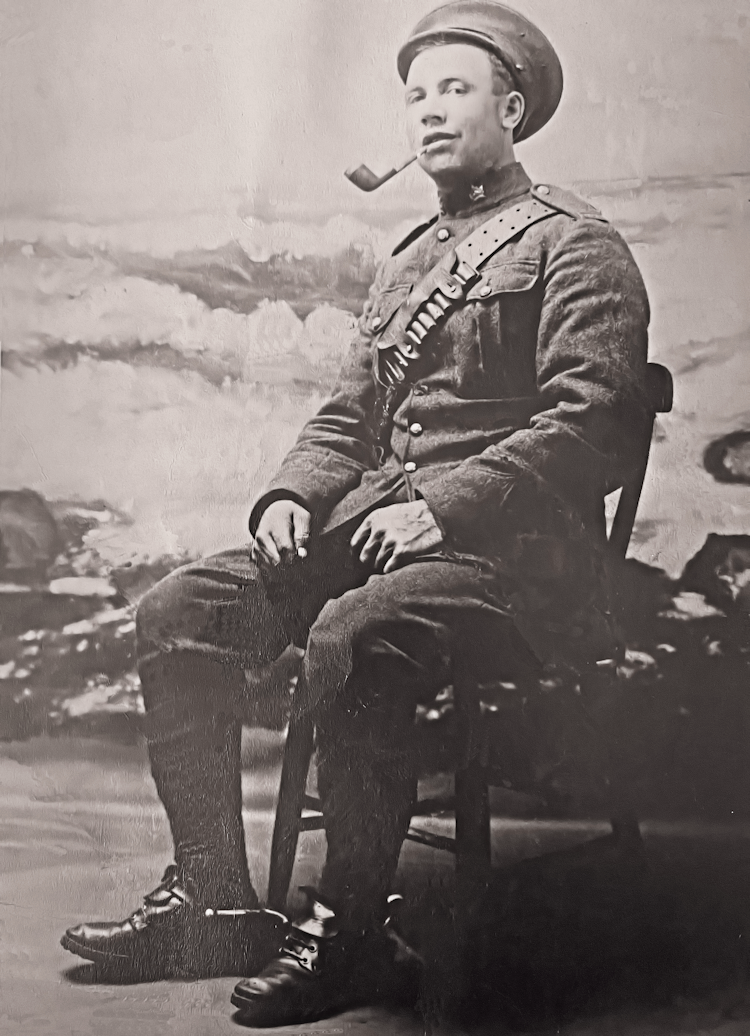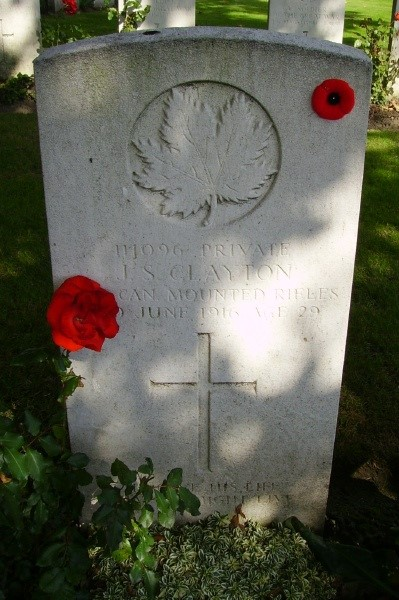
111096 Pte. Joshua Samuel Clayton was born on the 6th of October 1887 in Saint John, New Brunswick, to an English immigrant father, Joshua Pollit Clayton, and Canadian native mother, Eva Jane Scribner. Joshua's father had immigrated to Canada in 1885 and was hired at the Saint John Rural Cemetery as a Superintendent. Today this cemetery is known as Fernhill Cemetery. Due to the nature of Joshua Sr.'s work, he and Eva raised Joshua and his nine brothers and sisters on the grounds of the cemetery.
Tragedy struck the family constantly in the early 1900's. First Joshua's older sister died of consumption (today known to be tuberculosis) in 1906, making Joshua the eldest of the now nine children. Then Joshua's youngest brother sadly drowned while Joshua and middle brother Ernest were away training.
On 23rd February 1909 Joshua married a Saint John girl named Mary Agnes "Florence" Murphy. The couple briefly moved to Tisdale, Saskatchewan, where they had two children, Donald R Clayton, and Doris B Clayton. The marriage appears to have ended quickly as Joshua returned to Saint John and Fernhill Cemetery with the two children. Florence remained Out West and began a new family prior to Joshua's deployment. There is some speculation that there were some ill feelings based on Donald R Clayton's Second World War personnel file. In said file, Donald states that his mother is deceased. This is untrue as Florence Murphy lived until 1970, when she passed away in Tisdale. Additionally, Joshua lists his father as his next of kin when he enlists.
Joshua worked on the grounds of the cemetery as a labourer and as a chauffeur in the city. His middle brother and he also had joined the militia. Joshua had served with the 3rd Garrison Artillery Regiment as a bugler, and Ernest began his cavalry career early with the New Brunswick Dragoons.
Both Joshua and his brother travelled down to Amherst, Nova Scotia, in March of 1915. On the 30th they both attested and were assigned to the 6th Canadian Mounted Rifles as Privates. Joshua and 111095, Pte. Ernest Clayton, began training with the Battalion right away.
Joshua and Ernest, both made it through the entirety of training without being noticeably punished in Battalion records. This I found particularly remarkable as their younger brother, 2100375 Pte. Roy Edward Clayton, would later attempt to join an infantry battalion under age. He was kicked out of training after 6 months, but he later did serve when he was of age as a Battalion driver. Roy was charged for taking the brigade car without permission in 1918. Roy was accused of crashing the stolen brigade car and abandoning it. The damaged car was then scrapped by locals.

On the 18 July 1915 Joshua departed Canada aboard the SS Herschel. He and the remainder of the 6CMR were headed to England for additional training before being sent onto France and finally Belgium.
Joshua first entered the trenches in November of 1915, south of the Ypres Salient. He was under the instruction of veteran RCR (Royal Canadian Regiment) men, who were showing the 6CMR boys the ways of life in the trenches. A few of the 6CMR men were injured and killed within the first few weeks of going to the front.
On New Year's Day 1916 Joshua received a gunshot wound to the shoulder. It is unknown where he was at this time as it is not mentioned anywhere other than on Joshua's medical paperwork. He was released back to his unit later the same day. Over the next few days, the 6CMR was amalgamated with 4CMR under divisional restructuring, and Joshua and Ernest both joined the 4CMR, serving with the regiment for the remainder of their service.
Major C. H. McLean wrote of Joshua that he was "one of the company's most valuable scouts, absolutely without fear, and always leading.".
Joshua and Ernest were both in the front-line trenches when the Germans opened the 'Battle for Mount Sorrel' on the morning of 2nd June 1916. After the onslaught, both brothers were reported as MIA (Missing in Action). Joshua was listed as missing for the remainder of the Great War. His remains were located on 27th July 1922, and he was buried in the St. Julien Dressing Station Cemetery, where he rests today. Brother Ernest was taken POW and was repatriated to England in 1918.
Thanks and credit for the images and detailed biography go to Alex Clayton, Joshua's great great-grandson.
Thanks and credit go to Tim Bradley for submitting the following biography as part of a High School project back in 2015.
111096 Pte. Joshua Samuel Clayton was born to Joshua P. Clayton (father) and Eva Clayton (mother). They lived on Fernhill Street, in Saint John, New Brunswick, which, strangely, was a cemetery.
Although Joshua had a wife and a child he listed his father as his next of kin. His brother, 111095 Pte. Ernest Gerard I. Clayton, had his enlistment number one away from his brother. They more than likely did the attestation papers together. This might explain why Joshua put his father as his next of kin and not his wife.
Joshua had previous militia experience, having served 2 years as a bugler with the Garrison Artillery. He signed up in Amherst, in March 1915, and was assigned to the 6th Canadian Mounted Rifles.
Transferred to the 4th CMR on January 2nd, 1916, Joshua actually received a gunshot wound to the shoulder the day before, on January 1st.
Joshua was a sapper for the 4th CMR and was more than likely in a band during winter break because of his experience as a bugler in the Garrison Artillery.
On June 2nd, 1916, Pte. Joshua Samuel Clayton was killed in action during the 'Battle for Mount Sorrel'. Although he was initially reported as missing, believed killed, his was body was eventually located and he was buried at the St. Julien Dressing Station Cemetery, Belgium.
The 'Battle for Mount Sorrel' lasted for 13 days and was responsible for the loss of more than 10,000 Canadian, British and German men. For the 4th CMR, 607 men didn't answer to their names the day after it started.